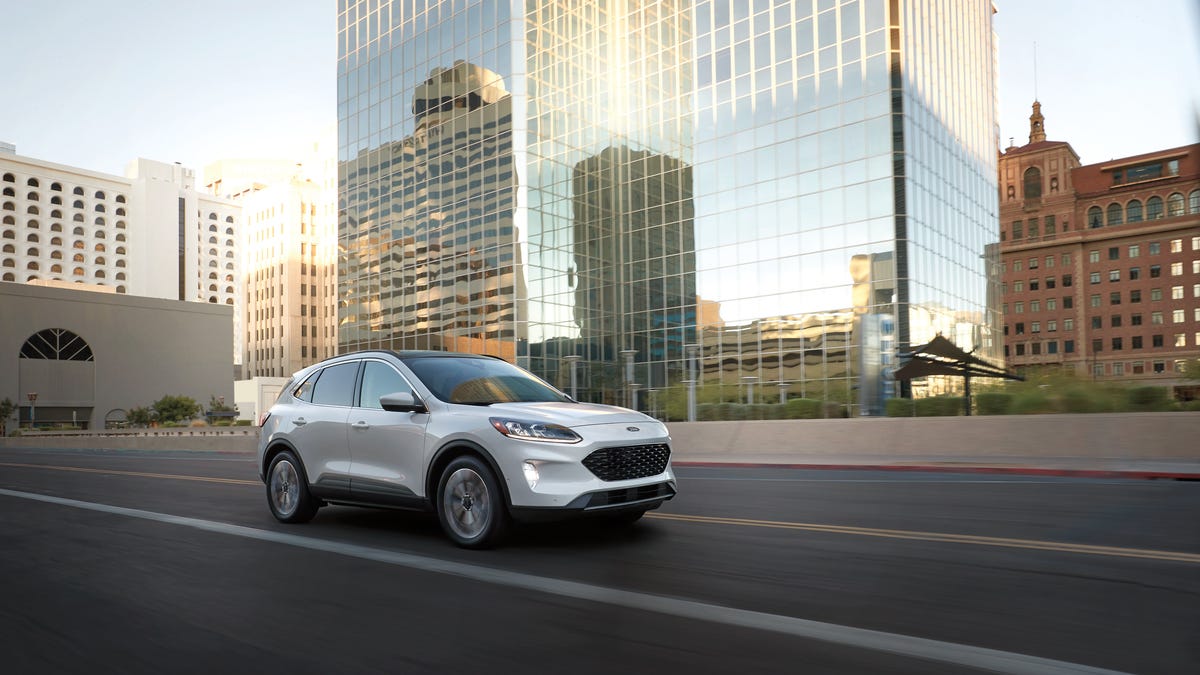
Ford Motor Company: Understanding the automaker’s history, legacy
Explore the rich history of Ford Motor Company, from its groundbreaking assembly line innovations to iconic cars like the Model T, Mustang, and F-150.
- Ford will end production of the Escape and Corsair SUVs by the end of 2025 to retool its Louisville plant for a new electric pickup truck.
- Analysts suggest the gap between the current models selling out and new replacements arriving could negatively impact Ford’s sales.
- Ford hints at a new small SUV to replace the Escape and Corsair, possibly an electric model, but details are scarce.
As Ford Motor Co. prepares for a revolution with a new manufacturing process and platform for electric vehicles, it also is saying farewell to the production of two popular small SUVs at year-end: the Ford Escape and the Lincoln Corsair.
Car buyers still will be able to buy those vehicles through 2026 and Ford does have a replacement in mind — but what it is and when it will arrive remain a mystery. And industry experts worry that if Ford leaves too big of a gap between when the Escape and Corsair sell out and a replacement arrives, sales could be dinged.
The Dearborn-based automaker said on Aug. 11 in Louisville, Kentucky, that it would retool its Louisville Assembly Plant, which currently builds the Escape and Corsair, to make a new midsize all-electric pickup. That new pickup would be the size of the Maverick midsize pickup and priced at $30,000 to go on sale in 2027.
Ford spokesman Mark Truby told the media that day that production of the Escape and Corsair will stop later this year so that Ford can start retooling the plant for the new EV pickup. Ford will have enough inventory of the Escape and Corsair SUVs to meet sales through 2026, Truby said.
He then hinted that a new small SUV will arrive to fill the space being vacated by the Escape and the Corsair. Truby declined to provide further details of what it might be or when it would come to market.
But it’s good to have a plan for a replacement, analysts said, considering the mistake Stellantis made a few years ago when it ended the Jeep Cherokee SUV without a replacement. Jeep sales took a hit and on Aug. 22, the automaker announced a remedy with a hybrid-powered Cherokee midsize SUV coming to market next year.
Analysts said Ford is still taking a gamble by ending the Escape and Corsair. The vehicles have been top sellers for their brands and are priced to bring new buyers to Ford and Lincoln brands. The absence of them, without an immediate replacement, could cost Ford sales and new customers, analysts said.
“An Escape-sized EV-based model is anticipated to follow the pickup at the Louisville plant in early 2028,” said Sam Fiorani, vice president of Global Vehicle Forecasting at AutoForecast Solutions. “While it may fill the void, there will be a two-year gap in production. Even if Ford is correct on the continued sales of ‘old’ Escapes through 2026, there will be more than a year before the new model hits showrooms.”
Love the Escape and Corsair? ‘Stay tuned,’ Ford said.
Ford spokesman Said Deep told the Detroit Free Press on Aug. 22: “These are important segments to compete, and we’re proud of our affordable Bronco Sport, Maverick and Mustangs, all of which are doing well in the market. Our new product in Louisville will also be in the affordable segment. If you loved our Ford Escape and Lincoln Corsair, stay tuned. We will have more to share later.”
Deep said Ford plans to continue production of its Kuga, the small SUV based on the Escape, that Ford sells in Europe. Also, company leaders have said that Ford will offer hybrid powertrains of all its current Ford brand gasoline-powered products in North America by 2030. The implication there is that even as Ford ends the Escape, something will replace it in the small SUV segment.
With a starting sticker price of $29,515 for a 2025 Escape, Fiorani explained that the entry-level vehicle is critical to attracting new buyers to the Ford brand because it provides options.
“Some of those new buyers are being introduced to Ford through the Maverick and the Bronco Sport, but Escape splits the difference as marginally more expensive than the base Maverick,” Fiorani said. Ford lists the 2025 Maverick as starting at $28,145. “If buyers want the crossover, they’re going to be pushed into the more profitable Bronco Sport, but if they’re looking at price, they’ll be pushed toward the Maverick.”
Ford began production of the Escape in 2000. The SUV was considered innovative at the time. It laid the groundwork for Ford’s strides in other technology and it delivered sales that helped carry Ford through the Great Recession in 2008.
Its sales remain solid today. From January through the end of June, Ford reported the Escape had sold 82,589 units in the United States, a 10.8% gain over sales of the vehicle in the year-ago period. That’s outselling Ford’s Bronco and Bronco Sport SUVs. Ford sold 72,438 Bronco Sports in that period, a 21% boost over the year-ago period and it sold 72,063 Broncos in that time frame, a 44% boost in Bronco sales from a year earlier.
So far this year, Corsair is the second-best seller in the Lincoln lineup. Ford launched the Corsair in 2020. According to Kelley Blue Book, the starting sticker price of the 2026 Corsair is $41,480. Ford reported sales of the Corsair are up 2% to 13,096 sold through the end of June compared with the same timeframe a year-ago. The only vehicle outselling it is the Nautilus at 18,533 through the end of June, a 6% jump from the year-ago period. The 2026 Nautilus starts at $55,535, Kelley Blue Book reports.
Ford can’t count on an EV replacement
Edmunds.com’s Ivan Drury noted that back in its “heyday” in 2014-18, Ford was selling more than 300,000 Escapes a year making it Ford’s second best seller behind the F-Series pickups. It remains a powerhouse.
“Ford might be thinking a bit too far into the future if there are any plans of completely removing Escape from the lineup,” Drury, head of Insights at Edmunds, told the Detroit Free Press. “Escape is still the company’s fourth best seller despite Bronco Sport’s introduction to the lineup in 2020 diverting consumer attention towards a vehicle with very different styling, but very similar average transaction prices of $33,226 for Escape and $34,243 Bronco Sport.”
An average transaction price is what a consumer pays after all discounts and trade-in values are applied to the manufacturer’s suggested retail price. Drury’s prices for the Escape and Corsair are all based on second-quarter average transaction price data.
Drury said during its lifetime, Escape has moved over 5 million units, giving it “a lot of nameplate equity.”
Corsair is “no slouch either,” Drury said. It represents nearly one out of every four Lincolns sold for 2025, giving consumers an entry point of $46,345 average transaction price versus the next model up in the lineup, the Nautilus at $59,630.”Ford can’t risk pulling the plug on either one of these vehicles without some plans for a true replacement involving an internal combustion powertrain,” Drury said. “Full electrification of the powertrain would be a nice option, but can’t be the sole choice as EV receptivity isn’t strong enough to support the sales volumes that these two models currently sustain.”
Edmunds data through July showed about 24% of Escape consumers choose either the hybrid or plug-in options. For the Corsair, the plug-in is chosen by consumers 18% of the time, Drury said.
“Neither one of these figures shows enough of even partial electrification preference for a full-fledged attempt at converting the entire customer base to EV only,” Drury said.
Ford sees an opportunity
Erin Keating, executive analyst at Cox Automotive, said that while neither the Escape nor Corsair are “an outlier in performance and both have seen declining sales” they’ve kept delivering solid sales and holding their own among Ford’s other models in their respective lineups.
Still, it would make sense, Keating said, that Ford sees an opportunity to revamp their entries in the segment with a U.S.-built EV SUV, while still carrying enough inventory of the outgoing Escape and Corsair cars to get Ford through at least another year before bringing a replacement to market.
“They haven’t announced this yet but one has to assume this is where they are headed,” Keating said, referring to an electric SUV replacement in that segment. “Additionally, I wouldn’t count them out for bringing these (models) back in multiple powertrain options.”
Morningstar Autos Analyst David Whiston said taking out the Escape and Corsair are part of the risks Ford CEO Jim Farley mentioned during his Louisville speech when unveiling Ford’s new plans for building EVs. Farley told the audience the risk in the new manufacturing process and EV platform is that there’s no guarantee they will succeed. Whiston lumps in ending the SUVs as part of the gamble.
“He’s also made comments on earnings calls for a while now that seem to show dislike of commodified crossover segments,” Whiston told the Detroit Free Press. “Doing niche stuff like Bronco instead makes sense for profits as long as you can still get good volume. But in the Escape and Corsair case, it’s a gamble to assume you can make it up on EVs that, at least initially, won’t have the profits of (gasoline-powered) models. This assumes they aren’t moving those models elsewhere.”
Whiston said he thinks Farley doesn’t want to compete head on with the likes of the popular Toyota RAV4 and Honda CR-V small SUVs, but prefers to “differentiate Ford” with a unique offering.
“That’s a great idea as long as the replacement sells,” Whiston said. “But EV penetration in the U.S. is going to take a lot of time to grow well beyond present levels nationally in the high single digits of new vehicle sales each year.”
Keating agreed, adding, “The compact SUV segment is for sure one of the most competitive with the RAV4 dominating and the Kia and Hyundai brands making real headway in capturing market share. Ford may also be signaling that it is all in on its much bigger models in otherwise profitable segments.”
A pivotal time for priorities
Dan Ives, managing director at Wedbush Securities, said this is a pivotal time for Ford and it is focused on finding profitability, especially in EVs. Ford’s Model-e unit, which is responsible for its EVs, lost $5.1 billion last year.
“Ford has to make tough decisions and this is a risky move to make shutting down these vehicles,” Ives told the Detroit Free Press. “It’s all about profitability and strategic focus for Ford and these were part of that strategy for Farley & Co.”
In short, automakers have to prioritize what comes next and in this world that would be an EV-focused future, said Kevin Roberts, director of economic and market Intelligence at car shopping site CarGurus. So while it is hard to see well-established models sunset, Ford’s decision reflects where the industry is heading globally.
“The focus on bringing more affordable EVs to market could help accelerate adoption in the United States,” Roberts told the Detroit Free Press. “Price has been one of the biggest hurdles to EV demand, so vehicles built at a retooled plant that come in at more accessible levels could have a meaningful impact on the market.”
Jamie L. LaReau is the senior autos writer who covers Ford Motor Co. for the Detroit Free Press. Contact Jamie at jlareau@freepress.com. Follow her on Twitter @jlareauan. To sign up for our autos newsletter. Become a subscriber.
Source link
#Ford #popular #SUVs #replace
